Teeth orthodontic braces are essential dental devices designed to align and straighten teeth, offering a functional and aesthetic improvement to your smile. For many individuals, the journey to achieving the perfect grin begins with understanding the various types of braces available, their costs, and what one can expect during treatment. This guide aims to provide you with in-depth knowledge about orthodontic braces, enabling you to make an informed decision when considering this transformative dental treatment.
Understanding the importance of teeth orthodontic braces
The significance of teeth orthodontic braces extends far beyond aesthetics; they play a crucial role in promoting oral health and improving functionality. Many people suffer from malocclusion issues such as overbites, underbites, or overcrowded teeth, which can lead to discomfort and difficulty in chewing or speaking. In addition, ignoring these problems can result in long-term damage to the teeth and jaw. Here, we explore why investing in orthodontic treatment is worthwhile.
Enhancing aesthetic appeal
Braces are often associated with adolescents, but their appeal spans all age groups.
A beautifully aligned set of teeth can greatly enhance one’s confidence and social interactions. As we live in a world where first impressions matter, having a captivating smile can open new doors and opportunities. Orthodontic braces effectively address misalignments and crooked teeth, transforming not just smiles but lives. Individuals wearing braces can participate in social events without the fear of judgment, leading to improved self-esteem.
Improving oral health
Beyond aesthetics, teeth alignment plays a fundamental role in maintaining oral hygiene. Misaligned teeth are more susceptible to plaque buildup because they create hard-to-reach spaces where food particles can trap bacteria. This accumulation can lead to gum disease, cavities, and other dental complications. By straightening teeth, braces facilitate easier cleaning and reduce the risk of oral health issues in the long run.
In fact, studies have shown that patients who have undergone orthodontic treatment tend to have healthier gums and lower instances of decay compared to those with misaligned teeth. Therefore, investing in orthodontic braces not only improves the appearance of your smile but also sets the stage for better overall health.

Addressing functional issues
Many people may not realize that improperly aligned teeth can significantly impair functionality. Speaking, chewing, and biting can all be affected by malocclusion. An underbite or overbite, for example, can cause excessive wear on certain teeth and lead to jaw pain. The changes brought about by orthodontic treatment can alleviate these issues, allowing patients to enjoy everyday activities without discomfort.
Moreover, the psychological benefits of resolving such functional problems cannot be understated. When individuals no longer experience discomfort while eating or speak without hesitation, it liberates them from the stress of worrying about their teeth.
Types and costs of teeth orthodontic braces
When it comes to orthodontic treatment, one size does not fit all. Various types of braces cater to different needs based on individual conditions and personal preferences. Below, we delve into the primary types of braces available, associated costs, and unique features that distinguish each option.
Metal braces: The time-tested classic
Metal braces remain the most common type of orthodontic appliance and are often the first option recommended by orthodontists.
Comprising stainless steel brackets and wires, metal braces have a straightforward design yet offer exceptional effectiveness in correcting a variety of dental issues. They can be customized with colorful bands, making them especially appealing to younger patients.
Pros and Cons of Metal Braces
While metal braces are highly effective, they come with both advantages and disadvantages that potential patients should consider carefully.
One significant advantage of metal braces is their durability and strength. Unlike other types of braces, they can withstand significant pressure, making them suitable for complex cases requiring extensive adjustments. Furthermore, they typically deliver faster results than alternative methods, often completing treatments within 6 months to 2 years.
On the flip side, metal braces are quite noticeable and can affect the wearer’s self-image, particularly among teens. The traditional “metal mouth” look can be a source of embarrassment and teasing. However, advancements in orthodontics have led to smaller brackets and more aesthetically pleasing designs, reducing the visibility of metal braces.
Ceramic braces: A more discreet option
Ceramic braces aim to address the aesthetic concerns associated with metal braces, making them a popular choice among adults and teens alike.
These braces utilize clear or tooth-colored brackets, blending more seamlessly with natural teeth. While they function similarly to traditional metal braces, ceramic braces offer a less conspicuous appearance.
Advantages and Disadvantages of Ceramic Braces
Ceramic braces excel in their ability to provide effective treatment while enhancing the wearer’s aesthetic appeal. For many, the reduction in visibility proves invaluable, allowing them to pursue orthodontic treatment without drawing unnecessary attention.
However, ceramic braces do come with their own set of challenges. Due to the material’s nature, they are more prone to staining than metal braces. Proper dental hygiene becomes imperative, necessitating diligent care to maintain their appearance throughout the treatment process. Additionally, ceramic braces can be slightly bulkier than their metal counterparts, potentially causing minor discomfort initially.

Speed braces: Efficiency meets innovation
Speed braces introduce a modern approach to orthodontic treatment, utilizing advanced technology to enhance treatment efficiency.
These braces feature smaller brackets and flexible wires, minimizing friction and allowing for quicker adjustments. The design allows for reduced treatment time, making them an appealing choice for individuals eager to complete their orthodontic journey sooner.
Benefits and Drawbacks of Speed Braces
Patients can experience significant improvements in treatment time with speed braces, often completing their plan within a shorter duration than traditional options. Moreover, the design of speed braces reduces discomfort associated with tightening appointments, making visits to the orthodontist a more pleasant experience.
Nevertheless, the cost of speed braces tends to be higher than that of traditional metal or ceramic options. Furthermore, their advanced technology may not be suitable for all cases, so consulting with an orthodontist is crucial to determine if they’re the right choice for you.
Invisalign: The clear alternative
Invisalign has revolutionized orthodontic treatment by introducing a discreet and comfortable alternative to traditional braces.
Utilizing custom-made, clear aligners, Invisalign offers a virtually invisible method of realigning teeth. Patients can remove their aligners during meals and for brushing and flossing, making it easier to maintain good oral hygiene practices.
Exploring the Pros and Cons of Invisalign
The primary allure of Invisalign is its invisibility, allowing patients to undergo treatment without the visible signs associated with metal or ceramic braces. This feature makes it especially appealing to adults seeking professional appearances.
Additionally, being removable enhances comfort and convenience, avoiding any dietary restrictions commonly associated with traditional braces. Patients can continue enjoying their favorite foods without worry, as there are no brackets or wires to limit their choices.
However, Invisalign does require discipline and commitment. To achieve optimal results, patients must wear their aligners for at least 22 hours daily. Failure to adhere to this guideline may lengthen treatment duration and compromise outcomes. Importantly, Invisalign may not be suitable for severe dental issues, making evaluation by an orthodontist essential.
Retainers: The final step towards perfection
After the active phase of orthodontic treatment, retainers play a crucial role in maintaining the results achieved through braces.
They help prevent teeth from shifting back to their original positions, ensuring long-lasting effects. Retainers can be fixed or removable, depending on patient preference and specific requirements outlined by the orthodontist.
The Importance of Retainers
Understanding the value of retainers highlights their necessity in the post-treatment phase. Even after spending considerable time in braces, the teeth are still susceptible to movement due to the underlying bone structure’s adaptability. Retainers serve as a safeguard against unwanted shifts, preserving the hard-earned results of orthodontic treatment.
Moreover, establishing a routine for wearing retainers can contribute to the overall success of orthodontic treatment. Regularly integrating retainers into daily life can lead to increased satisfaction with the final outcome. Neglecting this step can lead to unwanted changes in alignment, potentially resulting in the need for additional orthodontic work in the future.
Conclusion
Investing in teeth orthodontic braces is more than just a cosmetic enhancement; it’s a commitment to better oral health and functionality. Each type of brace offers unique advantages and considerations, allowing individuals to choose the option that aligns best with their needs and lifestyle.
Whether opting for traditional metal braces, discreet ceramic options, innovative speed braces, or clear Invisalign aligners, the journey to a beautiful smile is well worth the effort. With diligent care, regular orthodontic visits, and adherence to post-treatment guidelines like wearing retainers, anyone can achieve the smile they’ve always desired. Embrace the transformative power of orthodontic treatment and take the first step toward a lifetime of confidence and health.



SAIGON CENTER DENTAL CLINIC
Best dentist in Vietnam
Saigon Center Dental Clinic is proud to be one of the most prestigious dental clinics in Ho Chi Minh City with a variety of services: Single dental implant, Full jaw dental implant (especially All On 4, All on 6, and Zygoma Implant), Cosmetic porcelain crowns, Porcelain veneers, Braces, Clear braces, Tooth fillings, Wisdom tooth extraction, Treatment of toothache...
SAIGON DENTAL IMPLANTS CENTER
Best dentist in Vietnam
Saigon Implant Center - Dental Clinic utilizes the latest technology for specialized treatment in the field of Single implant, full jaw implants, All on 4 implants, All on 6 implants, Zygoma implant....